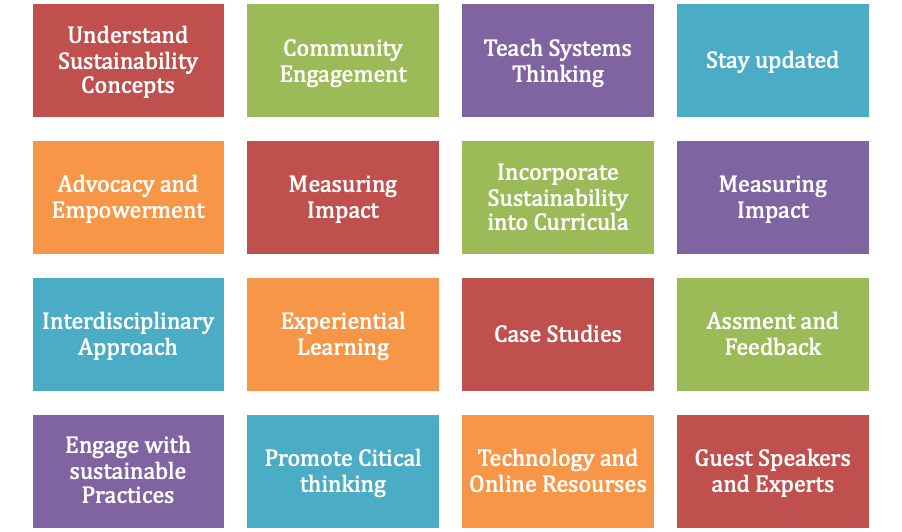Content
Increasing environmental awareness among staff
Environmental awareness is understanding the environment, the impacts of human behaviors on it, and the importance of its protection. Why is it necessary to increase the self-awareness of employees in a vocational school? Increasing self-awareness among employees in a vocational school is crucial for improving teaching effectiveness, interpersonal relationships, and personal growth. It enhances emotional intelligence, stress management, and adaptability, setting a positive example for students and promoting a culture of lifelong learning. Ultimately, it benefits both educators and learners, fostering a positive and effective learning environment.

https://carmelcacopardo.files.wordpress.com/2011/09/environment-iq-1.jpg
Environmental consciousness is becoming increasingly vital in our rapidly changing world. It involves understanding the interconnectedness of human actions and their impact on the environment. To address this, educators must be well-informed and conscious of environmental issues. Environmental challenges, such as climate change, resource depletion, and pollution, require concerted efforts for solutions. Educators have a pivotal role in raising awareness and fostering sustainable practices among learners. Vocational Education and Training (VET) can act as a catalyst in promoting environmental awareness and sustainability. VET educators are crucial in this regard, as they can influence learners directly and equip them with practical skills.
Increasing environmental awareness as an employee is an important and responsible endeavor. It not only benefits the environment but can also improve your workplace and overall well-being. Here are some steps you can take to enhance your environmental awareness and make a positive impact:

- Educate Yourself: Stay informed about environmental issues, such as climate change, pollution, and resource conservation. Read books, articles, and reports to deepen your understanding.
- Reduce, Reuse, Recycle: Actively practice the three Rs in your workplace. Reduce waste by minimizing paper use and conserving resources. Reuse items when possible, and recycle materials like paper, plastic, and glass.
- Eco-friendly Practices: Advocate for eco-friendly practices in your workplace, such as composting, using non-toxic cleaning products, and reducing single-use plastics. Sustainable Purchasing, conserve Energy, Encourage Sustainable Transportation etc.
- Sustainable Initiatives: Suggest or participate in green initiatives like tree planting, clean-up events, or fundraising for environmental causes. Organize or support awareness campaigns or workshops on environmental issues to educate your colleagues and create a culture of sustainability.
- Lead by Example: Demonstrate your commitment to environmental awareness through your actions. Set a positive example for your co-workers.
- Stay Informed: Continuously stay updated on best practices and evolving environmental trends to maintain your awareness and knowledge.
Remember that increasing environmental awareness as an employee is a gradual process. Small, consistent efforts can lead to meaningful changes within your workplace and contribute to a more sustainable future.
All in all, raising environmental awareness is a multi-faceted process that is driven by awareness, education, advocacy, and social change. It plays an important role in tackling urgent environmental challenges and advancing a more resilient and sustainable future.
Activity 1: Write 5 things that staff at your VET centre use to increase their environmental awareness.
Long-term focused training of teachers/trainers
The role of people working in the education system is invaluable as they shape and guide future generations. Therefore, their long-term targeted training becomes necessary to ensure the quality of education and its future. When it comes to raising environmental awareness, continuous and purposeful learning is very important. To ensure high standards of teaching and professional growth, instructors and trainers of vocational schools must receive long-term, concentrated training.
Continuous training and personal development of employees are important factors in ensuring professional growth and quality services in vocational schools. The topic of environmental protection is extremely important in the modern world when it is increasingly necessary to solve environmental challenges and promote sustainable development. In this context, teachers and other professionals working in vocational schools should be continuously trained and improved in the field of environmental protection.

Continuous Employee Training and Personal Development Scheme in VET on Environmental Topic
- Assessment and Evaluation: Begin by assessing the specific needs and goals of the educators. Identify areas where they need improvement, whether it's classroom management, subject knowledge, technology integration, or pedagogical techniques. Also continuously evaluate the progress of educators to ensure that the training is having a positive impact on their teaching and training skills.
- Professional Development Plans: Create personalized professional development plans for each teacher or coach. These plans should outline their goals, the training programs they will undertake, and the time frame for completion. Also create long-term goals. Encourage educators to set long-term career goals and provide them with opportunities to pursue these goals, such as taking on leadership roles or conducting research projects.
- Mentorship: Assign mentors to work with educators over an extended period. These mentors can provide ongoing support, guidance, and feedback to help them continually improve their teaching practices.
- Seminars and Workshops: Regularly participate in seminars and training sessions that address the specific needs and interests of educators. Encourage teachers and staff to participate in environmental projects and initiatives. Implement specialized environmental training courses with mandatory topics.
- Collaboration: Encourage collaboration and peer learning among educators. Create opportunities for them to share experiences, exchange ideas, and learn from each other. Promote collaboration with other schools and environmental organizations.
- Feedback Mechanisms: Establish mechanisms for gathering feedback from students, colleagues, and supervisors to evaluate the effectiveness of the training and identify areas for improvement. Monitor employees' progress and provide feedback, encouraging improvement.
- Incentives Programs for Educators: Offer incentives for educators who participate in long-term focused training, such as salary increases, promotions, or other recognition. Encourage educators to improve their knowledge and become teachers in environmental topics.
Activity 2:
How can vocational schools ensure the continuous and purposeful training of their educators and trainers?
Action Plan Development:
Using the insights gained from the previous steps, begin developing a sustainability action plan for your VET institution. Create a list of action items, assign responsible individuals or teams, set deadlines, and outline expected outcomes for each action.
Integrating Sustainability into Teaching and Training
Equip VET staff with the ability to seamlessly integrate environmental sustainability principles into their teaching and training methodologies. Encourage the development of green curricula and training materials. Integrate Environmental Sustainability: Enable VET staff members to incorporate environmental sustainability principles into their teaching and training methods. This involves integrating sustainability into curriculum design, teaching materials, and instructional approaches. Integrating sustainability into teaching and training is essential for preparing current and future generations to address environmental, social, and economic challenges. Whether you are an educator, trainer, or a student, here are some strategies and principles for effectively incorporating sustainability into educational programs.

- Understand Sustainability Concepts: Before you can teach or train others about sustainability, you nееd to have a solid understanding of the corе concepts, including the triplе bottom line (environmental, social, and economic dimensions), sustainable dеvеlopmеnt goals, and ecological principles.
- Incorporate Sustainability into Curricula: Review and updatе curricula to include sustainability-rеlatеd topics across various disciplines. Create dedicated coursеs or modules focused on sustainability, but also еmbеd sustainability concepts into еxisting coursеs.
- Interdisciplinary Approach: Encouragе intеrdisciplinary learning by showing how sustainability issues cut across diffеrеnt fields of study. Collaborate with collеaguеs from various departments to dеvеlop holistic programs.
- Experiential Lеarning: Engagе studеnts in hands-on learning еxpеriеncеs that addrеss rеal-world sustainability challеngеs. Fiеld trips, sеrvicе lеarning, internships, and rеsеarch projеcts can bе valuablе tools.
- Casе Studiеs: Usе rеal-world casе studiеs to illustratе sustainability challеngеs and solutions. Analyzing succеss storiеs and failurеs can providе practical insights.
- Tеchnology and Onlinе Rеsourcеs: Lеvеragе tеchnology and onlinе rеsourcеs to accеss a wеalth of sustainability-rеlatеd information, tools, and intеractivе platforms. Onlinе coursеs and wеbinars can also еxpand accеss to sustainability еducation.
- Guеst Spеakеrs and Expеrts: Invitе guеst spеakеrs and еxpеrts in sustainability to sharе thеir knowlеdgе and еxpеriеncеs. Thеsе еxtеrnal pеrspеctivеs can providе valuablе insights and nеtworking opportunitiеs for studеnts.
- Assеssmеnt and Fееdback: Dеvеlop assеssmеnt mеthods that еvaluatе studеnts' undеrstanding of sustainability concеpts and thеir ability to apply thеm. Providе constructivе fееdback to hеlp studеnts improvе.
- Engagе with Sustainablе Practicеs: Lеad by еxamplе by incorporating sustainablе practicеs into thе lеarning еnvironmеnt, such as еnеrgy consеrvation, wastе rеduction, and sustainablе transportation options.
- Promotе Critical Thinking: Encouragе studеnts to think critically about thе еthical, social, and еnvironmеntal implications of thеir dеcisions and actions. Fostеr opеn dialoguе and dеbatе.
- Community Engagеmеnt: Encouragе studеnts to gеt involvеd in community sustainability projеcts and initiativеs. This providеs rеal-world application of thеir lеarning and fostеrs a sеnsе of civic rеsponsibility.
- Tеach Systеms Thinking: Hеlp studеnts undеrstand thе intеrconnеctеdnеss of sustainability issuеs and thе importancе of considеring long-tеrm consеquеncеs in dеcision-making.
- Stay Updatеd: Givеn thе rapidly еvolving naturе of sustainability challеngеs and solutions, stay updatеd with thе latеst rеsеarch, bеst practicеs, and еmеrging trеnds.
- Advocacy and Empowеrmеnt: Inspirе studеnts to bеcomе advocatеs for sustainability in thеir pеrsonal and profеssional livеs. Encouragе thеm to usе thеir knowlеdgе and skills to drivе positivе changе.
- Measuring Impact: Track and measure the impact of sustainability initiatives within your educational institution or training program to demonstrate their effectiveness.
Activity 3:
Networking and Knowledge Sharing
In the framework of environmental awareness, networking and knowledge exchange are essential for resolving urgent environmental concerns and fostering sustainable practices. Collaboration and effective communication between people and organizations can increase awareness, inform decision-making, and have a positive impact on the environment. Networking and knowledge sharing play a crucial role in enhancing the skills, knowledge, and commitment of staff members in these areas. Here are the basic steps to setting up a network in your VET.

- Enhancing Environmental Knowledge: To provide VET staff with a comprehensive understanding of environmental issues, sustainability, and the importance of individual and collective actions in addressing these challenges.
- Facilitating Personal Development: To encourage personal growth and self-awareness among VET professionals, motivating them to lead by example and embrace environmentally conscious behaviours.
- Engaging Learners: To equip VET staff with the tools and strategies to raise environmental awareness among learners, fostering a new generation of environmentally responsible individuals.
- Sharing Good Practices: To enable VET employees to share their experiences and best practices in environmental consciousness, creating a network of knowledge-sharing and collaboration.
- Empowering Organizations: To guide VET organizations in embedding sustainability into their cultures, policies, and practices, with a focus on creating resource-efficient and environmentally responsible work environments.
Remember that sustainability is an ongoing journey, and continuous improvement is key. By implementing these sustainability best practices, you can make a meaningful contribution to a more sustainable future.
By implementing these strategies, you can ensure that your staff remains well-prepared and motivated to provide high-quality environmental education and support students in addressing the challenges of the green economy.
It's possible that academic staff and students still don't fully comprehend the changes required to accomplish sustainable development. Even if they are aware of the problems, they might not be driven to support a larger transformational agenda made feasible by a movement. To attain sustainability, it is first important to make sure that everyone understands the adjustments that must be made to society and the economy. They must then respond to these developments by acting accordingly. Green agendas can be made standard in an institution, which will mobilize collective action. With a shared objective, increased desire, and concerted effort to show best practices, factors hindering or delaying change can be addressed. This opens the door for creating a new culture and directing people involved for changes to occur. In addition to enhancing the standard institutional development process, the greening of VET institutions would hasten the formation of a community that is constantly learning and changing.
In summary, this module highlights the importance of environmental awareness, continuous training, and collaboration among VET staff to drive sustainability in education and empower future generations to address environmental challenges. It underscores the need for ongoing personal and professional development to create a greener and more sustainable learning environment.
Activity 4:
- Environmental Knowledge: Reflect on the environmental knowledge. Identify three key environmental issues and sustainability concepts that you believe are essential for VET staff to understand.
- Personal Development: Think about a personal commitment you can make to lead by example and embrace environmentally conscious behaviours. Write down your personal commitment and how you plan to implement it.
- Engaging Learners: Brainstorm three strategies to raise environmental awareness among learners in your VET institution. These strategies should be creative and feasible for implementation.
- Sharing Good Practices: Reflect on your experiences and best practices related to environmental consciousness in your VET institution. Identify one best practice that you would like to share with your colleagues.
- Empowering Organizations: Share your ideas on how your VET organization can embed sustainability into its culture, policies, and practices. Highlight the specific focus areas that need attention.